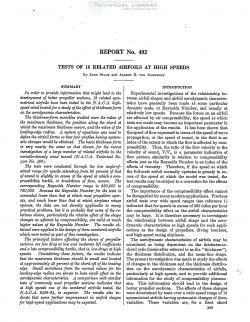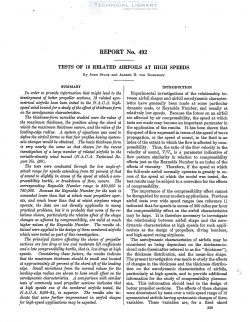naca-report-492

- Version
- 157 Downloads
- 1.45 MB File Size
- 1 File Count
- August 26, 2016 Create Date
- August 26, 2016 Last Updated
National Advisory Committee for Aeronautics, Report - Tests of 16 Related Airfoils at High Speeds

In order to provide information that might lead to the
development of better propeller sections, 13 related sym—i
metrical airfoils have been tested in the N.A.0’.A. high
speed wind tunnel for a study of the eject of thickness form
on the aerodynamic characteristics.
The thicknesszform variables studied were the value of
the maximum thickness, the position along the chord at
which the mawimum thickness occurs, and the value of the
leading-edge radius. A system of equations was used to
define the airfoil forms so that fair profiles having system-
atic changes would be obtained. The basic thickness form
is very nearly the same as that chosen for the recent
investigation of a large number of related ain‘oils in the
variable-density wind tunnel (NADA. Technical Re~
part No. 460).
The tests were conducted. through the low angle—of-
attack range for speeds extending from 35 percent of that
of sound to slightly in excess of the speed at which a com-
pressibility burble, or breakdown of flow, occurs. The
corresponding Reynolds Number range is 350,000 to
760,000. Because the Reynolds Number for the tests is
somewhat lower than that at which most propellers oper-
ate, and much lower than that at which airplane wings
operate, the data are not directly applicable to many
practical problems, but it is probable that some of the re-
lations shown, particularly the relative efi'ect of the shape
changes as afiected by compressibility, are valid at much
higher values of the Reynolds Number. The results ob—
tained were applied to the design of three cambered airfoils
which were tested as part of this investigation.
The principal factors afiecting the choice of propeller
sections are low drag at low and moderate lift coezficients
and a late compressibility burble, that is, low drags at high
speeds. Considering these factors, the results indicate
that the maximum thickness should be small and located
at approximately 40 percent of the chord aft of the leading
edge. Small variations from the normal values for the
leading-edge radius are shown to have small effect on the
aerodynamic characteristics. A comparison with similar
tests of commonly used propeller sections indicates that
at high speeds one of the cambered airfoils tested, the
N.A.0.A. 2409—34, is superior. The results also inr
dicate that some further improvement in airfoil shapes
for highrspeed applications may be expected.
| File | Action |
|---|---|
| naca-report-492 Tests of 16 Related Airfoils at High Speeds.pdf | Download |

Comment On This Post